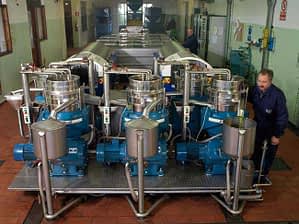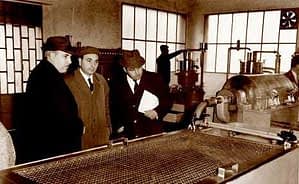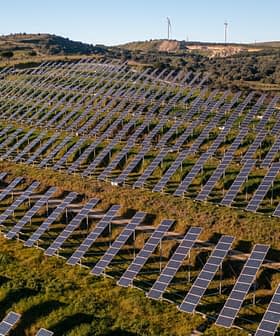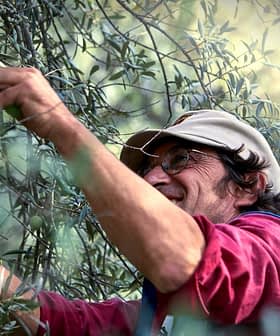For Family Making Olive Oil for 425 Years, Practice Makes Perfect

In the first of a two-part series, Lara Camozzo visits the renowned Frantoio Santa Tea in the Chianti Classico region of Tuscany, where the Gonnelli family has been making olive oil since 1585.
On an impossibly hot summer day in Florence, I make my way along the Arno to a small cafe where I’m to meet Signore Gonnelli’s son, Giorgio. After ordering a caffe macchiato, I spot him — tall and handsome, just my luck. We get into his beautiful new BMW and my heart starts beating faster — there’s air conditioning!
We’re on our way to Reggello, a small town in the province of Florence, where he grew up among rows upon rows of olive trees and still comes to escape from the heat of the city during the summer months. Sure enough, the temperature drops about 6 degrees as we approach Santa Tea, home to the Gonnelli family since 1585 when they first purchased the oil mill.
The mill itself was founded in 1426 — the original stone engraved with the date can still be seen on a side wall among terracotta pots and ancient machinery. “Thanks to the sales contract preserved in the archives by the Stato Notarile di Firenze, we know that the brothers, Francesco, Lorenzo and Giulio di Taddeo di Michele di Lorenzo Gonnelli bought the Santa Tea Farm from the monks of the Carmine Convent in 1585.”
The estate sits 400 meters above sea-level; its exposure to the south and its sandy, well-drained soil makes it an ideal place for the cultivation of olives. Beginning in October and lasting until the end of December, Santa Tea is a busy place; everyone is hard at work harvesting the olives by hand — during what is known as La Raccolta.
Giorgio leads me through their modern mill explaining the production process step by step. “During the harvest, all of the containers of olives arrive here,” he points to a large funnel-like tank, “where they are unloaded and transferred to the olive press.” As we walk around a conveyor belt that carries the olives to the wash tank, Giorgio shows me a wall stacked high with containers holding empty olive oil jugs and bottles. “Generally, during harvest season, the oil mill is overflowing with these containers,” he explains.
The harvested olives are then washed in a machine designed by Giorgio’s father, Piero Gonnelli, which removes with forced air all of the dirt, stones, leaves and twigs, until all you’re left with is the olive, “e basta.” Next the olives are passed through the temperature controlled press. “We have two lines of production — one is smaller, the other bigger. The smaller line is used principally for private production.” The olives are then turned through four long, rectangular tubs for an hour, until a type of pulp consisting of aqua nera, or dark water, olive oil, and the pit has been achieved. Pointing to the last machine in the room, Giorgio says, “This is the final phase of the pressing process — a bit like the refinement of wine — where the dark water is divided from the extra virgin olive oil. We want to eliminate the cloudy water in order to achieve an oil with a bright, clear color and a strong flavor.”

This oil is then passed through underground tubes into stainless steel holding tanks that are kept in another building where the bottling and labeling takes place. Giorgio knocks on several of the tanks causing a hollow sound to reverberate back at us, “We’re at the end of the season, so most of these are empty.” The tanks come in varying sizes and can hold anywhere from 80 to 115 kilos of olive oil. Unlike wine, which gets better with time, “Olio ha un tempo.” Oil should be enjoyed within two years of production. Throughout the season the oil is bottled as it is needed, to keep it as fresh as possible.
The Gonnelli’s produce ten different types of extra virgin olive oils made from several different olive varieties grown throughout their properties in the Arno Valley. Their selection ranges from Fruttato Intenso — Intense & Fruity, to Dolce Delicato — Sweet & Delicate, to Il Tradizionale.
I’m excited to learn that they are one of thirty olive growers involved in the production of Laudemio, one of my favorite Tuscan oils known for its superior quality, herbal, grassy flavor and clean, peppery finish. They also produce Piazza del Palio, from the region just outside of Siena, in addition to a DOP certified extra virgin olive oil that hails from the Chianti Classico region. This DOP certification guarantees that the oil has passed a quality process based on the territory from which it came — from harvest to bottling. Their Fresco di Frantoio olive oil is made from green and black olives picked during the middle of the harvest period, and is bottled without filtration — its neon green color is matched by its lively flavor. However, at a certain point in the season any unsold oil is pulled from the shelves due to a thin white sediment that forms in the bottom of the bottle — perfectly edible, but to consumers who don’t know the difference, “they find it disgusting,” Giorgio says. All of their other oil varieties go through a final filtration process to achieve the crystal green color consumers expect to see from a good quality extra virgin olive oil.
Giorgio lifts the lid to reveal the inside of the smallest machine I’ve seen yet. “This,” he says, “filters the olive oil.” At first glance, I see that the white filters are still stained with the last crop. As I lean in I am suddenly and overwhelmingly hit with a wave of the essence of olives — it’s so vibrant and pure, it actually smells green. I take a big gulping breath and am immediately transported far away from this summer heat, to a season when leaves crunch underfoot and the warmth of your breath hovers in the crisp morning air. As someone who grew up eating and cooking with Italian olive oil in the ‘States, I think to myself, “This is what it’s all about — this is the real deal.”
I suppose I had imagined a huge factory after learning that the Gonnelli family produces 500,000 bottles of extra virgin olive oil every year, yet their entire production is contained within two buildings. The second building houses bottles and cans of every shape and size — this is where the bottling and labeling takes place. The bare bottles arrive on a belt and are filled with olive oil from a tube that is connected to the steel tanks just around the corner in the storage room. They are then capped, labeled and sealed with a 100% Italian guarantee. This entire process, from pressing to bottling, “is airtight, without the presence of oxygen, in order to maintain the freshness and longevity of the product.” These bottles are then sold to supermarkets and restaurants throughout Italy, Europe, Japan, China, Russia, Korea, and the United States.
After receiving a bag full of goodies including six of their ten olive oils, Giorgio takes me down to the original mill where the developments in olive oil technology over the centuries are all apparent — the actual press and stone was prehistoric compared to the modern mill I’ve just toured. Standing there, underground, I can hardly imagine someone turning this wheel by hand through the frigid winter months, and am relieved to learn that the hard labor was shared in part with a mule. It’s clear that the world of olive oil has changed, and I’m amazed that the Gonnelli family has succeeded in keeping their mill’s history so alive and present for so many years. But in a country where the tradition of food is almost as important as the family that gathers around the table to eat it, is it really any wonder?
In the final segment in this series, an interview with Piero Gonnelli.












